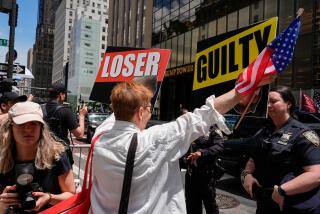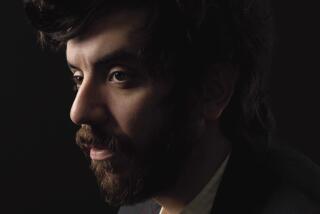The lure of heroism
- Share via
How do we manage to live in proverbially dreaded “interesting times”? Do we fashion a system of moral precepts for ourselves and follow them down the line, or do we look to Great Men and Great Women and somehow try to model ourselves and our actions after them?
In the wake of the Napoleonic wars and the gigantic European convulsions caused by one man on horseback, first Thomas Carlyle and then Ralph Waldo Emerson opted for the Great Man theory. Carlyle called his book “On Heroes, Hero-Worship and the Heroic in History” (1841), and Emerson’s was “Representative Men” (1850). On the whole, Carlyle’s group of military and political leaders is a little more worldly than Emerson’s; Emerson’s list inclines to writers and thinkers, although he does include Napoleon, just as Carlyle has a place for Dante and Shakespeare in his pantheon.
Carlyle and Emerson may have inspired their audiences to imitate or at least admire these grand figures. But the 20th century was not a happy time to be a partisan of Great Men. There were “isms” aplenty claiming that individual effort made no difference in the great game of history, but so many of those who seemed fueled by Napoleonic ambitions -- Hitler, Mussolini, Stalin -- were more noted for their murders, destruction and failures than for their ability to convey what Keats called “the genius above my grasp.”
William Pfaff, a political columnist for the International Herald Tribune, former political essayist for the New Yorker and author of “Barbarian Sentiments,” a finalist for the National Book Award in 1989, seems to follow the Carlyle-Emerson model in his new book, “The Bullet’s Song: Romantic Violence and Utopia,” by shaping an argument in terms of a group of individual biographies. T.E. Lawrence, Ernst Junger, Vladimir Peniakoff, Gabriele D’Annunzio, Willi Munzenberg, Andre Malraux and Arthur Koestler have chapters to themselves, and guest appearances are made by Che Guevara, Simone Weil and others.
Some of these names may be unfamiliar to most readers, others overfamiliar. They are less Carlyle’s or Emerson’s heroes than a rogue’s gallery -- cautionary figures to be held at arm’s length rather than emulated.
What ties them together, argues Pfaff, is their common romanticization of the world in which they aspired to play a heroic role. This is the “romantic violence and utopia” of his subtitle -- the intertwined threads of political engagement and epic adventuring that were so alluring to young men growing up while old empires fell and new ones sought to rise.
Disdain and sneaking admiration therefore often go hand in hand in Pfaff’s account. In fact, many of Pfaff’s subjects are colorful self-glamorizers along the lines of Lawrence in his Arabian robes or D’Annunzio gaudily mustering his private army to occupy Fiume in the aftermath of World War I. Junger, the dour frontline soldier and entomologist, perhaps has little of that obvious flamboyance. But a surface reticence is part of his own mode of self-presentation, like Hemingway striving for assertion by understatement or, in a phrase that has been applied to Lawrence, backing into the spotlight.
Virtually all of Pfaff’s subjects were also writers whose sense of warfare and their own masculinity was inseparable from its display. Pfaff tends to overvalue their opinions about war because they put them on paper, and, as a journalist himself, he almost inevitably concludes his argument with Koestler, the politically engaged writer who became elaborately disillusioned with so many of the causes and conflicts that shaped his career.
In part, that disillusionment is one of Pfaff’s points. To try to explain these lives and the century that contained them, Pfaff begins by invoking the idea of chivalry, which then collides with World War I, the slaughter that Pfaff grandiosely says “put an end to the perception of individual heroism as a social ideal.” In response to what seemed to be the death of the chivalric ideal, his subjects are archetypes who take a leaf from Romanticism, the artistic movement that flourished in the early decades of the 19th century. They style themselves as Romantic revolutionaries, fired with utopian ideals and intent on self-glorification, like Byron going to fight in the Greek War of Independence. This modern sense of chivalry, he argues, affords “the possibility for men to engage in the human tragedy of war while affirming humane values.”
Yet the criticism of the heroic goes in tandem with its celebration. Pfaff rightly calls World War I a turning point, but he downplays or glosses over the material causes -- mass armies, devastating weaponry, virtually immobilized trench warfare -- that helped create an array of men and some women (although not in Pfaff’s account) aching for a sense of personal heroism in a technology-driven world. Despite Pfaff’s claim that there is a strong argument for believing “European civilization [then] had no place for heroism,” ample numbers of real and fictional heroes have appeared in the decades since World War I. The urge to heroism, like the urge to nominate heroes, may slacken but never quite disappears.
Similarly, for all his invocation of the spirit of chivalry, Pfaff undervalues the role of greed, braggadocio and violence in its origins. When Pope Urban II preached the first crusade in the 11th century, he explicitly called upon those who otherwise waged wars for self-interest and plunder to remake themselves as “soldiers of Christ.”
Similar transformations from the brutal and self-seeking to the spiritual and selfless were rare enough in the last century. Accordingly, the most stimulating motives among Pfaff’s coterie and many more whose energies were enlisted by war were not so much chivalric as neo-chivalric. They tried consciously to revive the heroism of the past in a warrior nostalgia, itself forced into being by a technology that was no respecter of persons.
The result of Pfaff’s meditations on these matters is not quite intellectual or political history. There are too many broad strokes about big concepts. The argument can be alternately garrulous or excessively brisk. Along the way he tosses in odd tidbits of research (the number of newspaper issues published by Malraux in Vietnam), cryptically alludes to ideological and historical battles, and makes veiled allusions to Machiavelli and military strategist Karl von Clausewitz.
This impression of choppiness is not helped by a lack of editorial oversight, which allows details and stories to come up more than once with no acknowledgment of their previous appearances. Topics similarly pop up and disappear like drunken dolphins in a murky sea.
So it is difficult to decide whether “The Bullet’s Song” is a critique of romantic violence or a celebration of it. Pfaff says that he is neither an optimist nor a pessimist about the human condition but a realist. Yet his realism has a gloomy inevitability about it. “The moral function of war,” he says, recalling the instinctual-violence arguments of writers such as Robert Ardrey and Konrad Lorenz, “is to recall humans to the reality of the core of existence: the violence that is part of our nature.” Add to this his alignment with the “war makes me feel alive” idea explored (and criticized) so vividly by Chris Hedges in “War Is a Force That Gives Us Meaning,” and a reader might wonder why we care about preventing war at all.
“The Bullet’s Song” finally doesn’t tell us anything very interesting about the checkered history of chivalry or the influence of Romanticism, nor do its stabs at explaining Cold War communism and anti-communism. Its appeal is as a memoir rather than a history, a personal mythic journey through a group of frauds and adventurers. By recounting their lives, Pfaff seems to be trying to purge his own fantasies of war and heroism.
In that sense, the book’s real problem is that Pfaff is not more present. He is the glue that holds many disparate attitudes and opinions together, but for the most part we only get him between the lines. As he says in a revealing aside, “The influence of the twilight of chivalry can be seen among young men who read too much.” The main pleasure of his book is to follow him in this personal tramp through public history on the lookout for those colorful human road signs, galvanizing figures who influenced many -- and led them astray. *
More to Read
Sign up for our Book Club newsletter
Get the latest news, events and more from the Los Angeles Times Book Club, and help us get L.A. reading and talking.
You may occasionally receive promotional content from the Los Angeles Times.









